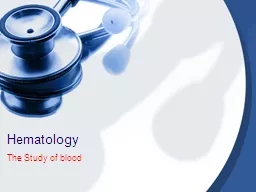

Average adult 810 pints of blood Composition PLASMA liquid portion of blood without cellular components Serum plasma after a blood clot is formed Cellular elements are red cells white cells and platelets ID: 911067
Download Presentation The PPT/PDF document "Hematology The Study of blood" is the property of its rightful owner. Permission is granted to download and print the materials on this web site for personal, non-commercial use only, and to display it on your personal computer provided you do not modify the materials and that you retain all copyright notices contained in the materials. By downloading content from our website, you accept the terms of this agreement.
Slide1
Hematology
The Study of blood
Slide2Average adult = 8-10 pints of blood
Composition:
PLASMA – liquid portion of blood without cellular components
Serum – plasma after a blood clot is formedCellular elements are red cells, white cells and platelets
Slide3PLASMA
Straw colored, contains –
Water
Blood proteins
Plasma proteins
FIBRONOGEN – necessary for blood clotting, synthesized in the liver
ALBUMIN – from the liver, helps maintain blood’s osmotic pressure and volumePROTHROMBIN – a globulin which helps blood coagulate. Vitamin K necessary for prothrombin synthesis.
Slide4Plasma
Nutrients
Electrolytes
Hormones, vitamins, enzymesMetabolic waster products
Slide5Erythrocytes-Red Blood Cell
Shape = biconcave discs
RBC
HEMOGLOBIN – gives red color, heme is iron and globin
is protein.
Function = transports oxygen to tissues and carbon dioxide away from cells
Normal – men =14-18 gm, women = 12-16 gm
Slide6Function of Hemoglobin
Red cells travel through the lungs where
O
2 is carried to tissues and releasedCO
2
picked up and carried back to lungs for exchange
Arterial blood – lots of oxygen = bright redVenous blood – lots of CO2 = dark crimson
Slide7ERYTHROPOIESIS
Manufacture of red blood cells
Occurs in bone marrow
Red cells live 120 daysOld cells broken down by the spleen and liverHEMOLYSIS – rupture or bursting of erythrocyte, can be from a blood transfusion or disease.
Slide8White Blood Cells – LEUKOCYTES
Larger than erythrocytes
5 types
Normal leukocyte count = 3,200 – 9,800 Types of White Cells
Neutrophils
Eosinophils
BasophilsLymphocytesMonocytes
Slide9Leukocytes
Basophils
produce HEPARIN – an anticoagulant
DIAPEDESIS – when white cells move through capillary wall into neighboring tissue.
Slide10PHAGOCYTOSIS – process when white cells surround, engulf, and digest harmful bacteria.
Slide11Inflammation
Body’s reaction to chemical or physical trauma
PATHOGENIC – disease producing microorganisms can cause inflammation
Symptoms – redness, local heat, swelling and painWhy? Bacterial toxins, increased blood flow, collection of plasma in tissues (edema)
Slide12HISTAMINE increases the blood flow to the injured area
PUS produced – a combination of dead tissue, dead and living bacteria, dead leukocytes and plasma
ABSCESS – pus-filled cavity below the epidermis
PYREXIA – increase in body temperature by the hypothalamus – in response to pathogenic invasion
Slide13Abscess
Slide14Inflammation
LEUKOCYTOSIS – increase in the number of white cells in response to infection
LEUKOPENIA – decrease in number of white cells due to chemotherapy or radiation
Slide15Thrombocytes (Platelets)
Smallest of solid components of blood
Synthesized in red marrow
Not cells – fragments of megakaryocytes
Necessary for the initiation of the blood clotting process
Slide16Coagulation (Clotting)
Cut or injury
platelets and injured tissue release THROMBOPLASTIN act on PROTHROMBIN in plasma
+ Calcium ions converts to THROMBIN
the thrombin acts as an enzyme and changes FIBRINOGEN FIBRIN creating a mesh that traps red blood cells, platelets and plasma creating a blood clot.
Slide17Slide18ANTICOAGULANTS – prevent blood clotting
HEPARIN =
antiprothrombin
PROTHROMBIN – dependent on Vitamin K
Slide19Blood Facts
There are about one
billion
red blood cells in two to three drops of blood. For every
600
red blood cells, there are about
40 platelets and one white cell.
Slide20Blood Types
Four major types of blood- A, B, AB and O
Inherited from parents
Determined by presence or absence of an ANTIGEN on the surface of the red blood cell
Slide21ANTIBODY – a protein in the plasma that will inactivate a foreign substance that enters the body.
Someone with type A blood has
b
antibodiesSomeone with type B blood has a antibodies
Someone with type AB blood has no antibodies
Someone with type O blood has
a and b antibodies
Slide22Slide23Blood Types
UNIVERSAL DONOR – O
UNIVERSAL RECIPIENT – AB
Red cells also may contain Rh factorIf you have it, you’re
Rh
+
If you don’t, you’re Rh –
Slide24RH Incompatibilties
Slide25Slide26Disorders of the Blood
ANEMIA
Deficiency in number or % of red cells
Slide27IRON-DEFICIENCY ANEMIA
Usually in women, children and adolescents
Deficiency of iron in the diet causing insufficient hemoglobin synthesis
Treat with iron supplements and green, leafy vegetables
Slide28APLASTIC ANEMIA
Bone marrow does not produce enough red and white blood cells
Caused by drugs or radiation therapy
Slide29SICKLE CELL ANEMIA
Chronic blood disease inherited from both parents
Causes the red cells to form in abnormal sickle shape
Sickle cells break easily and carry less oxygen
Occurs primarily in blacks
Treatment – blood transfusions
Slide30POLYCYTHEMIA
Too many red blood cells are formed
May be a temporary condition that occurs at high altitude
Slide31EMBOLISM
Air, blood clot, cancer cells, fat, etc. that is carried by the bloodstream until it reaches an artery too small for passage
Also known as a “moving blood clot”
Slide32THROMBOSIS
The formation of a blood clot in a blood vessel
The blood clot is a THROMBUS
Slide33HEMATOMA
Localized clotted mass of blood found in an organ, tissue or space.
Caused by an injury that can cause a blood vessel to rupture
Slide34HEMOPHILIA
Hereditary
Missing clotting factor
Blood clots slow or abnormally
Sex-linked – transmitted genetically from mothers to sons
Treat with missing clotting factor, avoid trauma
Slide35THROMBOCYTOPENIA
Not enough platelets
Blood will not clot properly
Slide36LEUKEMIA
Malignant condition
Overproduction of immature white blood cells
Hinders synthesis of red cells